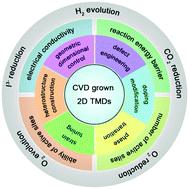当前位置:
X-MOL 学术
›
Energy Environ. Sci.
›
论文详情
Our official English website, www.x-mol.net, welcomes your feedback! (Note: you will need to create a separate account there.)
Atomic-scale engineering of chemical-vapor-deposition-grown 2D transition metal dichalcogenides for electrocatalysis
Energy & Environmental Science ( IF 32.5 ) Pub Date : 2020-03-19 , DOI: 10.1039/d0ee00450b Qichen Wang 1, 2, 3, 4, 5 , Yongpeng Lei 1, 2, 3, 4, 5 , Yuchao Wang 1, 2, 3, 4, 5 , Yi Liu 1, 2, 3, 4, 5 , Chengye Song 1, 2, 3, 4, 5 , Jian Zeng 1, 2, 3, 4, 5 , Yaohao Song 1, 2, 3, 4, 5 , Xidong Duan 5, 6, 7, 8 , Dingsheng Wang 5, 9, 10, 11 , Yadong Li 5, 9, 10, 11
Energy & Environmental Science ( IF 32.5 ) Pub Date : 2020-03-19 , DOI: 10.1039/d0ee00450b Qichen Wang 1, 2, 3, 4, 5 , Yongpeng Lei 1, 2, 3, 4, 5 , Yuchao Wang 1, 2, 3, 4, 5 , Yi Liu 1, 2, 3, 4, 5 , Chengye Song 1, 2, 3, 4, 5 , Jian Zeng 1, 2, 3, 4, 5 , Yaohao Song 1, 2, 3, 4, 5 , Xidong Duan 5, 6, 7, 8 , Dingsheng Wang 5, 9, 10, 11 , Yadong Li 5, 9, 10, 11
Affiliation

|
Chemical vapor deposition (CVD) is recognized as a powerful tool to synthesize atomically thin two-dimensional (2D) nanomaterials with the merits of high quality and uniform thickness with high efficiency, controllability, and scalability. Benefitting from the intriguing electronic and chemical characteristics, 2D transition metal dichalcogenides (TMDs) have attracted increasing attention with regard to energy-related electrocatalysis, including H2 evolution, CO2 reduction, O2 reduction/evolution, I3− reduction, etc. Atomic-scale tailoring of the surface and interface of CVD-grown TMDs is critical to not only improve the electronic structure and conductivity but also understand the intrinsic nature of the active sites. Therefore, a comprehensive and deeper understanding of CVD-grown 2D TMDs for use in electrocatalysis is urgently needed. In this review, the very recent advances in surface and interface engineering strategies, such as geometric dimensional control, defect engineering, doping modification, phase transition, strain tuning, and heterostructure construction, have been highlighted. Finally, the current challenges and perspectives are discussed. This review aims to provide the profound understanding and design of atomic-scale active sites in 2D TMDs for use in energy electrocatalysis.
中文翻译:

化学气相沉积生长的2D过渡金属二卤化物用于电催化的原子规模工程
化学气相沉积(CVD)被公认为是合成原子薄的二维(2D)纳米材料的有力工具,该材料具有高质量,厚度均匀,高效,可控制和可扩展的优点。从耐人寻味电子和化学特性中受益,2D过渡金属二硫属化物(TMDS)已经吸引了越来越多的关注关于能源相关电催化,含H的2演化,CO 2还原,O- 2还原/演化,我3 -还原,等等。CVD生长的TMD的表面和界面的原子尺度定制对于不仅改善电子结构和电导率而且了解活性位点的内在本质至关重要。因此,迫切需要对用于电催化的CVD生长的2D TMD进行全面而深入的理解。在这篇综述中,突出了表面和界面工程策略的最新进展,例如几何尺寸控制,缺陷工程,掺杂改性,相变,应变调整和异质结构构造。最后,讨论了当前的挑战和观点。这篇综述旨在提供对二维TMDs中用于能量电催化的原子级活性位点的深刻理解和设计。
更新日期:2020-03-19
中文翻译:

化学气相沉积生长的2D过渡金属二卤化物用于电催化的原子规模工程
化学气相沉积(CVD)被公认为是合成原子薄的二维(2D)纳米材料的有力工具,该材料具有高质量,厚度均匀,高效,可控制和可扩展的优点。从耐人寻味电子和化学特性中受益,2D过渡金属二硫属化物(TMDS)已经吸引了越来越多的关注关于能源相关电催化,含H的2演化,CO 2还原,O- 2还原/演化,我3 -还原,等等。CVD生长的TMD的表面和界面的原子尺度定制对于不仅改善电子结构和电导率而且了解活性位点的内在本质至关重要。因此,迫切需要对用于电催化的CVD生长的2D TMD进行全面而深入的理解。在这篇综述中,突出了表面和界面工程策略的最新进展,例如几何尺寸控制,缺陷工程,掺杂改性,相变,应变调整和异质结构构造。最后,讨论了当前的挑战和观点。这篇综述旨在提供对二维TMDs中用于能量电催化的原子级活性位点的深刻理解和设计。



























 京公网安备 11010802027423号
京公网安备 11010802027423号